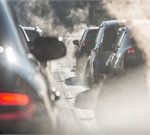Almost half of the U.S. population — 150 million people — are exposed to air pollution that puts their health at risk, the American Lung Association says.
Climate change is making air pollution worse due to record levels of particle pollution and higher ozone pollution (smog) caused by wildfires. Air pollution poses a threat to everyone, especially children, older adults and people with lung disease.
The effects of air pollution on lung health are of increased concern due to the coronavirus pandemic.
The association’s annual State of the Air report analyzed data from 2016, 2017 and 2018, which were among the five hottest years recorded in global history.
“The report finds the air quality in some communities has improved, but [it] finds that far too many people are still breathing unhealthy air,” American Lung Association president and CEO Harold Wimmer said in a news release from the group.
“This year’s report shows that climate change continues to degrade air quality and increase the risk of air pollution harming health,” Wimmer said.
“To protect the advances in air quality we fought for 50 years ago through the Clean Air Act, we must again act today, implementing effective policies to protect our air quality and lung health against the threat of climate change,” Wimmer said.
“Air pollution is linked to greater risk of lung infection. Protecting everyone from COVID-19 and other lung infections is an urgent reminder of the importance of clean air,” Wimmer said.
More than 20.8 million people lived in U.S. counties that had unhealthy levels of air pollution in all categories from 2016 to 2018, according to the report.
The report had two grades for particle pollution: one for short-term particle pollution (daily spikes), and one for the average annual levels. Particle pollution comes from wildfires, wood-burning stoves, coal-fired power plants, diesel engines and other sources, and can cause asthma attacks, heart attacks and strokes, and cause lung cancer.
The top 10 U.S. cities with the highest short-term particle pollution were: Fresno-Madera-Hanford, California; Bakersfield, California; San Jose-San Francisco-Oakland, California; Fairbanks, Alaska; Yakima, Washington; Los Angeles-Long Beach, California; Missoula, Montana; Redding-Red Bluff, California; Salt Lake City-Provo-Orem, Utah; Phoenix-Mesa, Arizona.
More than 21.2 million people lived in counties with unhealthy levels of year-round particle pollution. The top 10 U.S. cities with the highest year-round particle pollution were: Bakersfield, California; Fresno-Madera-Hanford, California; Visalia, California; Los Angeles-Long Beach, California; San Jose-San Francisco-Oakland, California; Fairbanks, Alaska; Phoenix-Mesa, Arizona; El Centro, California; Pittsburgh-New Castle-Weirton, PA-OH-WV; Detroit-Warren-Ann Arbor, Michigan.
Smog can cause shortness of breath, coughing and asthma attacks, and may shorten life. Warmer temperatures driven by climate change make smog more likely to form and harder to clean up.
The number of people exposed to smog was significantly higher in the 2020 report than in the previous three reports. More than 137 million people lived in a county with a failing grade for smog, according to the new report.
The top 10 cities with the highest levels of smog were: Los Angeles-Long Beach, California; Visalia, California; Bakersfield, California; Fresno-Madera-Hanford, California; Sacramento-Roseville, California; San Diego-Chula Vista-Carlsbad, California; Phoenix-Mesa, Arizona; San Jose-San Francisco-Oakland, California; Las Vegas-Henderson, Nevada; Denver-Aurora, Colorado.
“The science is clear: the nation needs stronger limits on ozone and particle pollution to safeguard health, especially for children and people with lung disease,” Wimmer said.
More information
The World Health Organization has more on air pollution and health.
Source: HealthDay
Copyright © 2025 HealthDay. All rights reserved.





-300x169.jpg)










